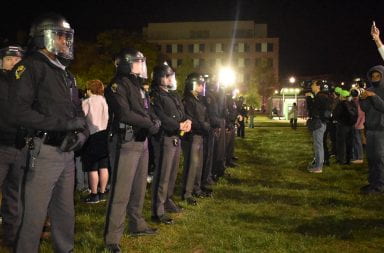![Local fashion experts guide college students through shopping and dressing for their upcoming summer jobs or internships. Credit: Dreamstime (via TNS) [Original caption: How does smart casual differ from snappy casual, glitzy casual, dressy casual, party casual and business casual?]](https://www.thelantern.com/files/2024/04/LIFE-FAM-BORGMAN-COLUMN-DMT-7432064dd4242c4c.jpg)
Local fashion experts guide college students through shopping and dressing for their upcoming summer jobs or internships. Credit: Dreamstime (via TNS) [Original caption: How does smart casual differ from snappy casual, glitzy casual, dressy casual, party casual and business casual?]
With internship season gearing up and graduates entering the workforce, students may be rummaging through their closets in search of the proper attire, scrambling to determine how to “dress to impress.”
Luckily, local fashion industry experts Ann Paulins — an Ohio State Department of Human Sciences clinical associate professor who has specialized in fashion and retail professional development — and Candace Read — the women’s style director at Columbus-based fashion consultant firm Wardrobe Therapy — have advice for elevating students’ wardrobes so they can express their individual styles in a professional environment.
Paulins said before panickedly buying a whole new wardrobe, it is crucial to do some background research on the workplace’s expectations.
“What I would suggest to students who plan on immersing themselves in a professional workplace such as an internship is to research the company,” Paulins said. “It is important to know the company’s norms, the dress code and the environment.”
Read agreed, especially with workplace standards having shifted in recent years.
“So much has changed since [COVID-19], and different office environments have changed,” Read said. “I think it’s critical to dial into the culture at the company, and then from there, you dig into your personal style, but make sure it parallels the company ethos.”
For spaces with a particularly formal dress code, Paulins recommends students invest in the staples.
“I think it’s imperative to buy basics you can wear in many different ways,” Paulins said. “Regardless of gender, basic pants — khaki and black are good colors that a lot of tops are going to go with. Kind of like a shawl are basic kinds of tops that you can put [on], like a cardigan sweater or blazer, which could be a more professional-leaning blazer or casual-leaning blazer.”
Accessories like belts and blazers are optimal to enhance the base of one’s business attire, Paulins said. These additional pieces can also be helpful when needing to accord with multiple dress codes or styles in the same day, she said.
“Belts can be versatile, and you can put cardigan sweaters and blazers over your tops, which can be more professional,” Paulins said. “You can go from ‘smart casual’ to professional with a basic pair of pants. Through layering, you can transcend seasons and switch your daytime outfit into an after-hours one.”
Commonly, workplace settings will lean more toward a “business casual” atmosphere, Read said. She said this style exists somewhere between formal and casual, and is a great way to style an elevated, relaxed look.
“Business casual can be preferred in many environments,” Read said. “We’re seeing business casual a lot, often meaning you can wear a nice dark denim with a more elevated blouse or even a more fitted crisp T-shirt with a blazer over it.”
As an even more casual alternative, Read said “snappy casual” is a newer style that allows for a more everyday take on business attire, enabling individuals to implement more personality into their outfits.
“Snappy casual is found in many creative environments, such as creative agencies,” Read said. “It allows you to show a little bit more of your personality, and all of that is good.”
Regardless of the particular fashion norms within a workplace, Paulins said it is imperative for interns to not only consider their clothing but also their general appearance.
“Always prioritize being well groomed,” Paulins said. “Don’t have an unkempt, just-rolled-out-of-bed look. Make sure you’re always looking polished.”
Though many students may feel stressed about shopping for workplace-appropriate attire due to financial concerns, Paulins said there are ways to work around a college-student budget and find cheaper alternatives.
Specifically, Paulins said she recommends planning ahead when shopping for clothes, seeking out thrift stores, requesting hand-me-downs from friends and family members and purchasing neutral-colored attire that can be reworn as core pieces.
“Students need to be effective and efficient with money,” Paulins said. “Not all students have all kinds of money to purchase a new wardrobe, so you can wear things multiple times a week and exchange your clothing.”
Ultimately, Paulins said comfort and confidence are key. She said students shouldn’t have to stifle their identities in order to conform to a workplace’s dress code and, if they do, there may be other, non-fashion-related questions worth asking.
“If you can’t be you, then you really need to think about why you want to work there,” Paulins said. “You don’t want to be someone you’re not every day, so do that research about all aspects of the company and think about the type of opportunities you are seeking in the workplace.”


